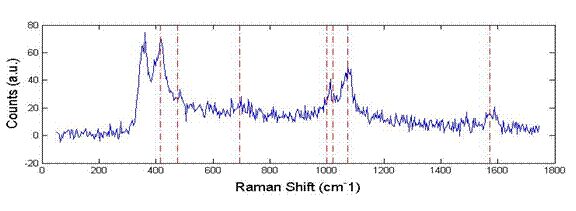
ACS PRF | ACS
All e-Annual Reports

44289-AC5
Understanding Large Enhancements in Surface-Enhanced Raman Scattering Using Lithographically Fabricated Metallic Bowtie Antennas
The goal of this research is to explore mechanisms for the extremely high enhancements of surface-enhanced Raman scattering (SERS) observed for molecules chemisorbed on metallic bowtie nanoantennas. Our bowtie nanostructure consists of two sub-100 nm metallic Au triangles placed tip-to-tip with a small gap. We have previously shown both computationally and experimentally that a bowtie with a ~15 nm gap enhances the local optical intensity by a factor of 1000 in a region roughly 20 nm on a side. At the same time, since SERS signals from single molecules near colloidal gold particle pairs have been reported, both chemical as well as electromagnetic enhancements must contribute to produce the required 1014 enhancement needed. In contrast to colloidal gold studies, the bowtie structure provides a useful foundation for exploring the extremely large enhancements for a case where the electromagnetic enhancement contribution is known.
Our work to explore the SERS process on bowtie nanoantennas has proceeded along two fronts. First, we have shown that the basic enhancement effect does not specifically require amine functionality in the chemisorbed molecule by recording SERS from small numbers of benzenethiol molecules. Second, we have performed SERS measurements under conditions of precise electrochemical control which has allowed us to specifically determine the orientation of the molecules on the bowtie.
A. Generality of SERS Enhancement Process: To explore the generality of the SERS enhancement process, we have extended our earlier successful studies of p-mercaptoaniline to an amine-free chemisorbed molecule, benzenethiol attached to the Au bowtie surface.
SHAPE \* MERGEFORMAT The figure above shows a spectrum obtained from a single bowtie in our confocal scanning Raman spectrometer. It is essential to note that this spectrum was acquired from as few as 103 to 104 molecules located close to the bowtie gap. The characteristic Raman modes of benzenthiol are shown by the dotted lines. As was the case with p-mercaptoaniline, the spectrum was observed to fluctuate in both amplitude and the frequency of specific modes, thus providing a useful conclusion: the nonresonant SERS enhancement effect we see on gold bowties does not require amine functionality and is more general than expected. This constrains certain aspects of the putative charge-transfer model which has been implicated in the chemical portion of the enhancement. B. SERS of Molecules on Bowties with Control of Electrochemical Potential: Second, we have built a new ultrasensitive confocal Raman setup which includes the ability to control the electrochemical potential at the surface of the bowitie. The cell allows the incorporation of bowtie samples on a transparent (ITO-coated) substrate as working electrode, simultaneously with optical spectroscopy in the inverted configuration. This experimental capability allows study of molecule-metal, in this case molecule-bowtie, contacts in more detail, since a controlled electrochemical potential can be used to manipulate the Helmholtz-layer at the interface and with it the potential drop across the interface. This situation can be considered similar to the interface region in molecular electronic devices. In our SERS spectra of self-assembled monolayers (SAMs) of para-mercaptoaniline (pMA) on individual Au bowties a striking and reproducible turn-on behavior of b2-symmetric vibrational modes has been observed after cycling the electrochemical potential over a limited range (figure above part a). The switching-on was correlated with a surprising roughening of the SAM-covered bowties (SEM images in figure b,c; bar, 100 nm). The roughening is attributed to oxidation of the gold substrate. A detailed analysis of the spectra combining group theory selection rules and finite-difference time-domain calculations suggests that, starting from a well-defined relative orientation between adsorbed molecules and local electromagnetic fields on the bowtie, the substrate roughening induces a transition to a variety of unknown relative orientations due to changes in local field distribution and possibly molecular reorientation. The lack of b2 modes for the pristine bowtie proves that the molecules were initially oriented flat on the metallic surface. This finding demonstrates the power of Raman spectroscopy using well-defined metallic nanostructures to elucidate details of the interfacial geometry. 
